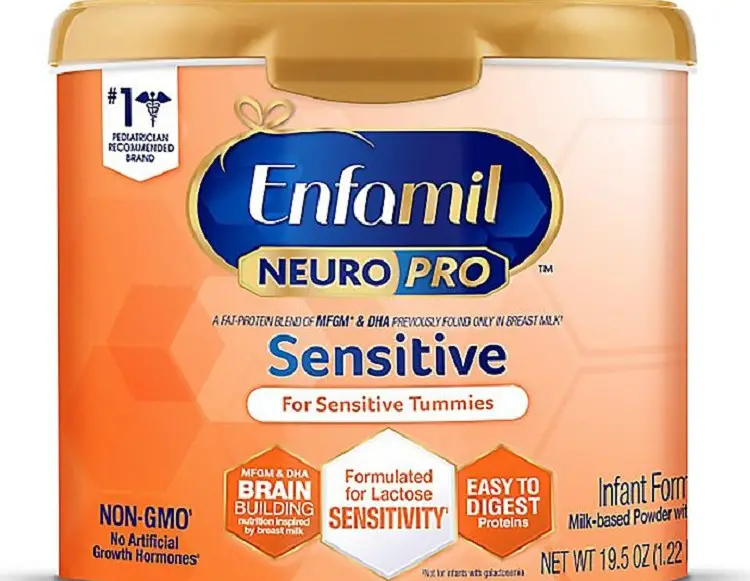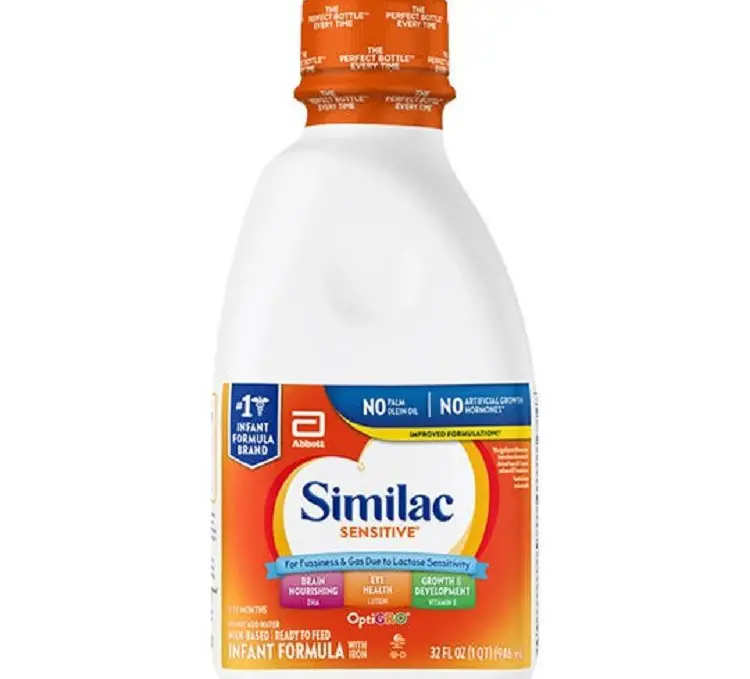It is not out of place for a mother to want the best for her baby. Part of this concern comes to mind when the mother has to make a decision, and such a decision may become dicey regarding food issues.
Holding a child and breastfeeding a baby is undoubtedly beautiful, but not all mothers are lucky to have such an experience. As a result, the use of formula substitutes becomes inevitable.
The question of Enfamil Sensitive vs Similac Sensitive may bother a mother who has a baby with a sensitive stomach. Ride on with me as answers to your questions are provided in this article.
Table of Contents
- What is a Sensitive Formula?
- Enfamil Sensitive vs Similac Sensitive: Nutritional Overview
- Enfamil Sensitive vs Similac Sensitive: Product Breakdown
- Enfamil Sensitive vs Similac Sensitive: Similarities & Differences
- Final Verdict
What is a Sensitive Formula?
When a formula is referred to as sensitive or gentle, it simply means that it is a different version from what you know.
This formula becomes a go-to area when your baby shows fussiness and discomfort.
Sensitive formulas are formulas that lack lactose which is milk sugar or contain lactose or milk sugar in small quantities or formula with a ratio of whey to casein higher than its constituents in regular baby formula.
Sometimes sensitive formulas contain broken down protein, and the reason broken down protein is incorporated in its manufacture is to aid digestion of the formula in your baby’s system.
Sensitive formulas aid in digestion, helps in the release of gas, and then reduce spit-up by your baby after consumption of the milk, and then decrease the symptoms of colic your baby might be displaying.
Enfamil Sensitive vs Similac Sensitive: Nutritional Overview
One of the most critical factors in treating your baby’s stomach sensitivity is the ingredients that make up the formula.
You must understand what they are, how they benefit your baby, and if the product does what it says it will.
Enfamil Sensitive

Enfamil Sensitive is a product or formula manufactured by the Enfamil brand for babies with a sensitive stomach and who display intolerance to the presence of lactose in their system.
It is not ideal or suitable for infants with galactosemia. According to Enfamil’s website, their sensitive formula contains the following nutritional constituents:
| Vegetable Oil (coconut, soy, palm olein, and high oleic sunflower oils) | Whey Protein Lipid Concentrate (milk) |
| Corn Syrup Solids | Mortierella Alpina Oil |
| Milk Protein Isolate | Zinc Sulfate |
| Potassium Citrate | Calcium Carbonate |
| Calcium Phosphate | Cupric Sulfate |
| Schizochytrium Sp. Oil | Magnesium Phosphate |
| Sodium Chloride | Potassium Chloride |
| Riboflavin | Calcium Pantothenate |
| Potassium Iodide | Biotin |
| Niacinamide | Thiamin Hydrochloride |
| Inositol | Ferrous Sulfate |
| Ascorbic Acid | Choline Chloride |
| Potassium Iodide | Vitamin A Palmitate |
| Sodium Selenite | Vitamin E Acetate |
| Soy Lecithin | Vitamin B6 Hydrochloride & Vitamin B12 |
| Thiamin Hydrochloride | Vitamin D3 |
| Folic Acid | Vitamin K1 |
| Taurine | L-Carnitine |
Read: Enfamil Vs Kendamil
Similac Sensitive

This is a sensitive formula produced by the Similac baby’s formula brand for babies with sensitive stomachs.
The formula contains ingredients that are essential for the healthy development of your child, and the nutritional constituents include:
| Milk protein isolate | Short Chain Fructooligosaccharides |
| Soy oil | Sugar |
| C.Cohnil oil | Beta-Carotene |
| Coconut oil | Ferrous Sulfate |
| M. Alpina oil | Thiamine Hydrochloride |
| High Oleic Safflower oil Corn syrup | Zinc Sulfate |
| Potassium Chloride | Sodium citrate |
| Lutein | Calcium Carbonate |
| Taurine | Calcium phosphate |
| Ferrous Sulfate | Magnesium phosphate |
| Calcium Pantothenate | Magnesium chloride |
| Vitamin A Palmitate | d-Alpha-Tocopheryl Acetate |
| Vitamin D3 | Folic Acid |
| Vitamin B12 | Copper Sulfate |
| Potassium Hydroxide | Biotin |
| Sodium Selenate | Potassium Iodide |
| Manganese Sulfate | Riboflavin |
| Nucleotides | Niacinamide |
| Pyridoxine Hydrochloride | Choline Bitartrate |
| Choline chloride | Inositol |
| Ascorbic acid | L-Carnitine |
| Soy Lecithin | Mixed Tocopherols |
| Ascorbyl Palmitate | Phylloquinone |
In terms of nutritional constituents, Similac has many more than Enfamil. However, Enfamil is more suitable for infants with lactose intolerance since Similac’s formula has milk solids.
Though Enfamil contains milk, they advertise it as being lactose-free. This isn’t very clear. On the other hand, Similac’s formula has a lot of sugar in it, although milk-based.
Some desirable ingredients contribute to the presence of vitamins, minerals, metals, and other micronutrients in Enfamil that are absent from it.
Additionally, many people report problems with their babies after consuming Enfamil’s formula.
So, Similac is the winner in terms of nutritional constituents. While it would seem Enfamil Sensitive would win out here, its effect on infants is the determining factor.
Many parents and caregivers a concerned about how Enfamil affects their baby’s digestion. This is not the case with regards to Similac.
Enfamil Sensitive vs Similac Sensitive: In terms of Breast Milk Comparison
Another important consideration is the formula’s overall nutrition to being as close to breast milk as possible.
One of the most crucial reasons for using formula is when mom can’t produce enough milk. So, the nutritional composition must be close.
Additionally, breast milk’s nutritional content changes over time, especially when colostrums are included.
There are about 60 calories in linoleic-acid-rich breast milk, 7 grams of carbs, 4 grams of fat, and about one or two grams of protein.
Enfamil Sensitive
Considering the typical nutritional value of breast milk, Enfamil’s sensitive formula gets an 8 out of 10 due to its high linoleic acid content.
As a regular replacement, it will work fine despite the calories, fat, and carbohydrate.
The only thing to be worried about is its high-fat content. Breast milk fat content isn’t that high, and babies don’t necessarily need that much.
Here are the exact measurements for the most important nutritional values:
- Calories: 100
- Protein: 2.1 grams
- Fat: 5.4 grams
- Carbs: 10.9 grams
- Water: 133 grams
- Linoleic Acid: 1000 milligrams
Similac Sensitive
Similac Sensitive gets a 7 out of 10 points despite having the same nutritional value as Enfamil.
This rating is due to the low linoleic acid content, which should be equal to or higher than breast milk. Linoleic acid aids in building strong bones, muscles, eyesight, and hearing.
In terms of nutrition, Similac Sensitive contains more protein than infants need. The closer to two grams of the formula, the better it will be in mimicking breast milk.
- Calories: 100
- Protein: 2.2 grams
- Fat: 5.3 grams
- Carbs: 10.9 grams
- Water: 132 grams
- Linoleic Acid: 780 milligrams
Read: Formulas That Taste Closest To Breast Milk
Enfamil Sensitive vs Similac Sensitive: Product Breakdown
Enfamil Sensitive
Pro
- It contains a lot of vitamins, electrolytes, nutrients, and minerals
- These constituents are essential for your baby’s development and growth
Cons
- It contains milk additives that may not be suitable for babies with a sensitive stomach
- There have been complaints about indigestion and increased fussiness
- There is a chance of your baby experiencing constipation
Similac Sensitive
Pro
- The formula takes care of your baby’s gas and fussiness
- It supports brain development
- It also supports eye development
- The product also supports the development of strong bones
- It contains no artificial growth hormones
Cons
- Despite the wide range of nutritional ingredients used in its manufacture, it forms many bubbles when mixed with excessive foam.
- It doesn’t subside entirely even if you put the bottle in a fridge overnight or stir it gently.
- It also contains an unnecessary high sugar content that may not be too good for infants, probably to sweeten the taste and make it more appealing to children.
Read: Enfamil vs Nan Pro vs Similac: Which is the Best?
Enfamil Sensitive vs Similac Sensitive: Similarities & Differences
Similarities
- Both are ideal for babies with sensitive stomachs.
- They have near identical nutritional value.
- You can use both formulas from day one up to 12 months.
- Both formulas are non-GMO
- Both formulas contain DHA.
- Both formulas contain vitamins.
Differences
- Similac Sensitive has more ingredients utilized in its manufacture than the one used in the manufacture of Enfamil sensitive.
- Enfamil Sensitive seems a better alternative for infants with lactose intolerance since Similac’s formula contains milk solids.
- Similac Sensitive contains more sugar than Enfamil sensitive.
- Similac Sensitive has many desirable ingredients that contribute to many vitamins, minerals, metals, and other micronutrients lacking in Enfamil Sensitive.
- Enfamil sensitive has high linoleic acid content, while Similac sensitive has a low linoleic acid content.
- Similac Sensitive formula has a higher consistency than Enfamil sensitive formula.
- Similac Sensitive formula is lactose-free, while Enfamil sensitive uses a broken down lactose protein.
Read Also:
- Enfamil vs Aptamil
- Aptamil Comfort vs Similac Total Comfort
- Enfamil Nutramigen vs Enfamil Sensitive
- Similac Pro Advance vs Enfamil Gentlease – Which is the Best?
Final Verdict
Similac Sensitive wins out regarding ingredients and nutritional constituents as being closest to breast milk.
However, remember that both products are meant for babies with sensitive stomachs, so you should give this formula to babies showing lactose intolerance signs.
Go through the various features and choose the one you feel will be ideal for your baby. Hopefully, this article has given you in-depth knowledge on Enfamil Sensitive vs Similac Sensitive.
Every child is unique, so try and also consider your child while making choices because it is the child that will consume the formula.
